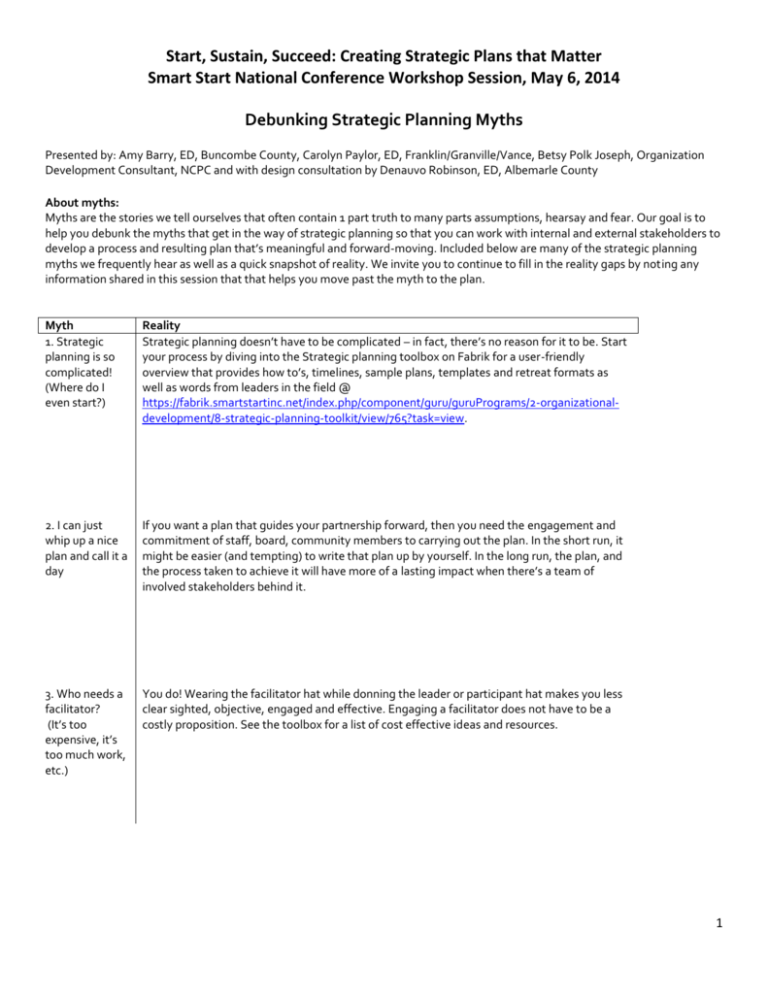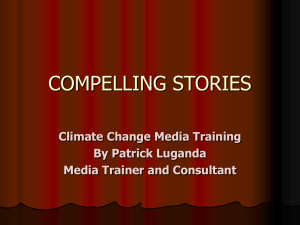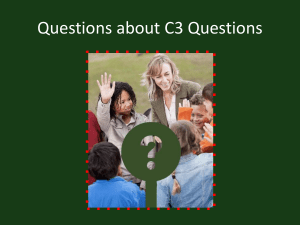A Strategic Plan is
advertisement

Start, Sustain, Succeed: Creating Strategic Plans that Matter Smart Start National Conference Workshop Session, May 6, 2014 Debunking Strategic Planning Myths Presented by: Amy Barry, ED, Buncombe County, Carolyn Paylor, ED, Franklin/Granville/Vance, Betsy Polk Joseph, Organization Development Consultant, NCPC and with design consultation by Denauvo Robinson, ED, Albemarle County About myths: Myths are the stories we tell ourselves that often contain 1 part truth to many parts assumptions, hearsay and fear. Our goal is to help you debunk the myths that get in the way of strategic planning so that you can work with internal and external stakeholders to develop a process and resulting plan that’s meaningful and forward-moving. Included below are many of the strategic planning myths we frequently hear as well as a quick snapshot of reality. We invite you to continue to fill in the reality gaps by noting any information shared in this session that that helps you move past the myth to the plan. Myth 1. Strategic planning is so complicated! (Where do I even start?) Reality Strategic planning doesn’t have to be complicated – in fact, there’s no reason for it to be. Start your process by diving into the Strategic planning toolbox on Fabrik for a user-friendly overview that provides how to’s, timelines, sample plans, templates and retreat formats as well as words from leaders in the field @ https://fabrik.smartstartinc.net/index.php/component/guru/guruPrograms/2-organizationaldevelopment/8-strategic-planning-toolkit/view/765?task=view. 2. I can just whip up a nice plan and call it a day If you want a plan that guides your partnership forward, then you need the engagement and commitment of staff, board, community members to carrying out the plan. In the short run, it might be easier (and tempting) to write that plan up by yourself. In the long run, the plan, and the process taken to achieve it will have more of a lasting impact when there’s a team of involved stakeholders behind it. 3. Who needs a facilitator? (It’s too expensive, it’s too much work, etc.) You do! Wearing the facilitator hat while donning the leader or participant hat makes you less clear sighted, objective, engaged and effective. Engaging a facilitator does not have to be a costly proposition. See the toolbox for a list of cost effective ideas and resources. 1 4. I don’t have time for planning or for implementing An effective strategic plan actually saves time by providing your partnership with a renewable roadmap that guides decisions, actions and resource allocations. To ensure that time is well spent include realistic timeframes (with actions distributed over time and not all at once), clearly identified and balanced (don’t let it all fall to one person, please) responsibilities & accountabilities for carrying out the process and implementation. 5. Data is so overrated To make the case for the importance of data, imagine a partnership that focuses its vision on creating healthier lifestyles for children. If the vision is based on solid, relevant data, it moves the community in meeting an important need. But what if the vision isn’t connected to data? It’s not necessarily relevant and runs the risk of wasting time, energy and resources on issues that aren’t community priorities. 6. a. To be good, it has to be a 5 year plan…. There’s no “have to” when it comes to most aspects of planning, including the duration of your plan. Whether it’s 5 years or 7, what matters is that you keep it alive by continuously updating it. That way, instead of having to overhaul it every 5 years, your plan can keep moving forward and evolving with the partnership. 6 b. And it must be a beautiful and very complex plan Use the time and energy you’d invest in creating a beautiful plan to develop a plan that’s leading your partnership in a compelling future direction. We’ve seen too many fancy plans sitting on shelves while other simple, straightforward plans become the roadmap for the partnership, guiding its actions, decisions and resource allocations. On a related point, It’s important for your plan to be clearly written but resist the urge to wordsmith by committee … it will only drag you and the entire process down. 7. We really had a great plan, then it sat on the shelf See above. Plans can’t accomplish anything if they are not used. The dashboard model is an easy way to keep track of your successes and determine next steps. 2 Strategic Planning Terminology The process, overall: Strategic plan: A simple roadmap that’s built to last. Plans don’t have to be fancy; they just need to be meaningful and inspiring to you and the members of your community. Strategic planning process: An opportunity to convene community members to create a compelling vison that reflects common community values, identify the strategies to get there and actively engage in actions that strengthen the work of the partnership. Key tenets of a meaningful process and plan: Community: As tempting as it might be to write the plan by yourself, you’ll get much more out of the plan, process and outcomes when you actively involve your community of staff members, board members and/or community stakeholders. Diverse perspectives enrich strategic plans and process AND community engagement encourages buy-in and support of outcomes. Core values: These are the beliefs that matter to you and the members of your community – forming the tenets of your local partnership. Values should be clearly reflected in the vision . Vision statement: This is the brief but compelling statement that describes the desired future you are excited about achieving together. Mission statement: This statement describes the purpose of your local partnership. Mission and vision statements are often lumped together but are very different. It might be helpful to remember that the mission is the ground your partnership stands on as it reaches towards achieving the vision. Essential ingredients for a strong, sustainable plan: Goals: 3-6 statements that bring the vision to life. It’s tempting to have more goals – but the more goals, the greater the odds that the plan will become too unwieldy and complex to implement. One way to assess your goals is the SMART Method: Is your goal Specific? Measurable? Attainable? Relevant? Time-based? The Web is filled with helpful SMART resources, including https://edis.ifas.ufl.edu/fe577. Strategies: These are high level measurable phases the partnership puts in place to achieve the goals. Actions: The Who, What, When and How of your plan provide a clear roadmap for accomplishing strategies. Success standards: Throughout the process, continuously ask: what will success look like when we achieve this? As the process moves forward, identify and track measures and determine how and when you will assess achievement of each goal. 3 A Strategic Plan is … Strategic plans aren’t scary because … They are better when they’re simple. There’s no need for your plan to be glossy or fancy. It just needs to set a future direction, you, your staff and stakeholders are excited about and committed to reaching. They matter because it’s achieving a vision and fulfilling core values that are meaningful to you and your partnership. They provide an exciting opportunity to convene community members (staff, board and a cross-section of community stakeholders) to come together to create a compelling vison that reflects common community values, identify the strategies to get there and actively engage in actions that will strengthen your partnership as you achieve your goals (communities of practice) Good plans are made to last. When your plan is simple and meaningful, it can easily be woven into the way you do your work. No need to start from scratch every 5 years. Well, that’s nice but how do I make that happen? Create a team. No need to go this alone. Involve your community. The pay-offs include a richer plan, an energized process and a ready team of people bought into outcomes and excited about results. Ask appreciative questions that engage your community in visioning, planning and implementing. Example: How can we work together to achieve our dreams for the Partnership? What will our Partnership look like when we achieve these dreams, together? Examine your beliefs: With your community, reflect on the responses to your appreciative questions and listen for the core values that form the foundation of your work – you will be amazed by the shared values that emerge. Create a vision statement that reflects these appreciative thoughts Engage your community in opportunities to explore the future and reflect these ideas in the vision. Ok, so what’s next? Bring your community together to put legs on that vision. Work together to figure out: What are the goals we are working together to accomplish that will bring this vision to life as we fulfill our values? What strategies will operationalize these goals? What are the actions we can take to make it all happen? Who will be responsible for what (accountability) and when (timetable)? How many goals and strategies do we really need? To be effective, a plan has to be do-able. A plan with 201 complex goals looks great on paper but is it really going to get done? If you develop a plan with 3 to 6 goals that are clear, measurable and relevant with strategies and actions that are inspiring and, yet, achievable then you will have a n effective strategic plan. As time goes by you add new goals and check off the ones that have been accomplished. Your plan is an evolving document that’s actively used, not one that looks pretty on bookshelves. 4 5 Are we almost done? You’re almost there. Now take a good look at that plan. Does it reflect your partnership’s values? Does it move it toward reaching a compelling vision? Is it supported by the mission? Do the goals bring the vision to life? Are the strategies and actions aligned with goals, do-able and engaging? We have a plan… Now what? Make it a part of the way work is done in an ongoing way. Keep it front and center. Revisit regularly. Involve others. Measure progress. Move forward! 6










